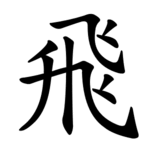Radical 183
Appearance
(Redirected from 飞)
| 飛 | ||
|---|---|---|
| ||
| 飛 (U+98DB) "fly" | ||
| Pronunciations | ||
| Pinyin: | fēi | |
| Bopomofo: | ㄈㄟ | |
| Wade–Giles: | fei1 | |
| Cantonese Yale: | fei1 | |
| Jyutping: | fei1 | |
| Japanese Kana: | ヒ hi (on'yomi) と-ぶ to-bu / と-ばす to-basu (kun'yomi) | |
| Sino-Korean: | 비 bi | |
| Hán-Việt: | phi, bay | |
| Names | ||
| Japanese name(s): | 飛ぶ/とぶ tobu | |
| Hangul: | 날 nal | |
| Stroke order animation | ||
 | ||

Radical 183 or radical fly (飛部) meaning "flying" is one of the 11 Kangxi radicals out of 214 composed of 9 strokes.
In the Kangxi Dictionary, there are 92 characters (out of 49,030) to be found under this radical.
飞, the simplified form of 飛, is the 57th indexing component in the Table of Indexing Chinese Character Components predominantly adopted by Simplified Chinese dictionaries published in mainland China, while the traditional form 飛 is listed as its associated indexing component.
Evolution
[edit]-
Oracle bone script character
-
Large seal script character
-
Small seal script character
Derived characters
[edit]| Strokes | Characters |
|---|---|
| +0 | 飛 飞SC (=飛) |
| +12 | 飜 (=翻 -> 羽) |
| +18 | 飝 (=飛) |
Sinogram
[edit]The radical is also used as an independent Chinese character. It is one of the Kyōiku kanji or Kanji taught in elementary school in Japan.[1] It is a fourth grade kanji.[1]
References
[edit]- ^ a b "The Kyoiku Kanji (教育漢字) - Kanshudo". www.kanshudo.com. Archived from the original on March 24, 2022. Retrieved 2023-05-06.
Literature
[edit]- Fazzioli, Edoardo (1987). Chinese calligraphy : from pictograph to ideogram : the history of 214 essential Chinese/Japanese characters. calligraphy by Rebecca Hon Ko. New York: Abbeville Press. ISBN 0-89659-774-1.
- Lunde, Ken (Jan 5, 2009). "Appendix J: Japanese Character Sets" (PDF). CJKV Information Processing: Chinese, Japanese, Korean & Vietnamese Computing (Second ed.). Sebastopol, Calif.: O'Reilly Media. ISBN 978-0-596-51447-1.
External links
[edit]Wikimedia Commons has media related to Radical 183.



